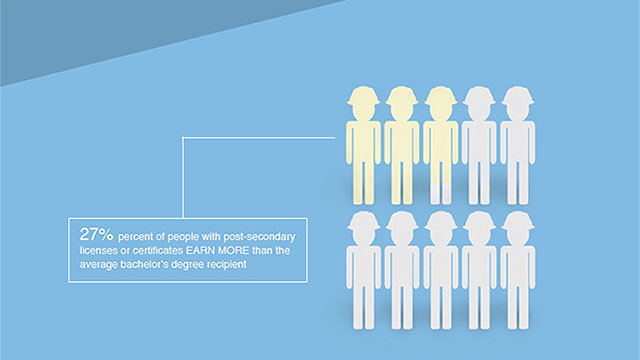The shift in American education
How career and technical training is making a comeback
By Ryan Wilder
Whether you see it every day in your job, have a child enrolled in public school, or just follow the hot-button topics in the news, you’ve no doubt heard the term “Skills Gap.” It’s used to describe the disparity between the skills employers are looking for and the skills available workers have to offer, and it’s having a big impact on hiring. A December 2012 report from the McKinsey Center for Government found that nearly 40% of employers cite a lack of skills as the main reason for their entry-level vacancies.
As millions of Americans remain unemployed in the aftermath of the economic recession, many wonder why so many employers can’t find what they’re looking for. The lawmakers, educators and employers who have sought the answer to this question have focused largely on education legislation to promote college and career readiness and partnerships between school systems and industry.
In 2011, the Harvard Graduate School of Education released a landmark report entitled Pathways to Prosperity. Among the report’s many findings was that 27% percent of people with post-secondary licenses or certificates - credentials short of an associate’s degree –earn more than the average bachelor’s degree recipient. Not surprisingly, many other recent reports and studies have found that public education’s focus on 4-year college degrees has led to diminished emphasis on Career and Technical Education (CTE, historically termed “vocational education”) and career-readiness. Career and college readiness has become an important topic as policymakers, educators, and business professionals look for new ways to ensure students are prepared to succeed after high school, whether their next step is college, training or certification programs, or the workforce. CTE has been championed by lawmakers and educators alike as the key to improving college and career-readiness by providing core academic skills, employability skills and technical, job-specific skills.
Currently, the U.S. House of Representatives is discussing re-authorization of the Carl D. Perkins Vocational and Technical Education Act, which provides nearly $1.3 billion in annual federal support for CTE programs in all 50 states, including support for integrated career pathways programs. The Perkins Act expired in 2012, but the ongoing legislative narrative suggests that it will be reauthorized this year.
Rep. Tod Rokita (R-IN), who chairs the House education subcommittee that deals with K-12 issues, stated at a recent hearing on Perkins: “CTE coursework should provide students with opportunities to obtain relevant certificates, credits, and hands-on experience that will allow them to more seamlessly integrate into the workforce or get ahead in their quest to earn a post-secondary degree.”
Plenty of evidence exists to support the need for increased support for CTE programs in high schools and community colleges. Data from the Association for Career and Technical Education (ACTE) shows that high school students involved in CTE are more engaged, perform better and graduate at higher rates. With respect to graduation rates, the difference is significant. The average high school graduation rate for students concentrating in CTE programs is 90.18 percent, compared to the national average freshman graduation rate of 74.9 percent.
At the post-secondary level, enrollment in CTE has been shown to foster program completion and prepare students and adults for in-demand careers. In fact, research commissioned by the Bill and Melinda Gates Foundation from 2009 found that 4 out of 5 secondary CTE graduates who pursued post-secondary education after high school had earned a credential or were still enrolled two years later.
While politicians are showing increased interest in promoting CTE, student engagement with the relevant, hands-on learning available through CTE courses appears to be on the rise as well. According to a recent survey of teachers and administrators who work in education that emphasizes pathways to college and careers conducted by the National Center for College and Career Transitions, 81 percent reported that enrollment in CTE programs was at least the same or higher than three years ago. Respondents also predicted that CTE programs and career academies will grow over the next three years.
In addition to the federal funding for CTE available through the Perkins Act, states are also taking measures to increase support for CTE. In the past year, numerous states across the country have either passed or are considering legislative measures aimed at making CTE more accessible to America’s youth. Other states have developed successful partnerships between industry and education stakeholders to improve the quality and availability of CTE programs in secondary and post-secondary education. Some of the most innovative and promising state programs designed to support CTE include:
Kansas
In Kansas, a new state program that pays students’ tuition to help them pursue a technical education is getting glowing reviews from students and leaders alike.
Under legislation passed in 2012, Kansas pays tuition for students who learn technical skills during their junior and senior years of high school. The students spend part of their school day in typical high school classes and the rest attending technical or community colleges to learn skills such as graphic design, welding or nursing assistance.
The program was a big success in its first year, with the number of high school students taking such courses at the state’s 26 community or technical colleges increasing from 3,870 students to 5,800. Enrollment numbers are expected to increase again this year. Last year, the state paid $12 million in tuition, which school administrators and officials at the Kansas Board of Regents and Kansas State Department of Education say is money well spent.
“It’s a great initiative to help students,” said Blake Flinders, vice president for workforce development at the Kansas Board of Regents, “but it also helps Kansas employers.”
The program helps students learn a job skill while helping address workforce shortages in many fields, he said.
The regents worked with the Kansas Department of Labor to determine high-demand industries they hope students will consider. High school students can earn industry-recognized certifications before leaving school for many of the jobs in those industries, such as electricians, diesel engine mechanics, carpenters and HVAC mechanics.
High schools also profit, getting an extra $1,000 in state funds for each student who earns a certificate. Statewide, 711 students earned certificates during the 2012-2013 school year.
Louisiana
At a recent congressional subcommittee hearing focusing on CTE, Alvin Bargas, president of Louisiana’s Pelican Chapter of the Associated Builders and Contractors, said, “Public high schools almost exclusively focus on the four-year college prep curriculum for all students. While this pathway is important, students should be offered opportunities to learn skills that prepare them for the many high paying, in-demand careers that do not require a bachelor’s degree.”“Our challenge ahead is to focus our current resources to support CTE programs for in-demand industries that provide students with innovative and flexible training options that stretch from high school to advanced post-secondary credentials,” Bargas said. “This includes promoting new and existing partnerships between industries, government, and education providers while establishing clear accountability indicators and easily understood measures of success.”
In his testimony, Bargas also highlighted Louisiana’s Course Choice program, which allows high school students to customize their learning paths by gaining industry-based certifications, in addition to earning high school and college credit. The Course Choice program allows students access to hundreds of in-person and online academic and career education courses often not available in traditional schools, ranging from college prep classes to welding and electrical training. Approved course providers include five public school districts, every public college and university in Louisiana, Louisiana-based course providers and virtual schools. As of August 2013, nearly 3,500 Louisiana students were enrolled in the Course Choice program. ABC Pelican Chapter is a Course Choice provider and NCCER Accredited Training Sponsor offering electrical, pipefitting and welding.
In addition to programs created by legislation, industry and education are also working together in Louisiana. Driven by a projected massive increase in industrial construction activity in the state, the Louisiana Workforce Investment Council, a panel of business leaders that advises the governor and the Louisiana Workforce Commission on the state’s workforce needs, recently approved a plan called “Building Louisiana’s Craft Workforce.” The plan was developed over several months by a coalition of business, industry, labor unions and government organizations.
The plan includes a number of facets, from making sure that Pell Grants can be used to pay for training classes at community and technical colleges, to having career counselors work with middle and high school students so they consider careers in the industrial construction industry, to getting more state money to pay for worker training. The Workforce Investment Council also recently announced a partnership with Build Your Future to develop a construction recruitment and image enhancement initiative specifically focused on the needs of Louisiana.
Joe May, president of the Louisiana Community and Technical College System (LCTCS), said there’s been a shift in thinking about training for careers in the skilled crafts. Around 1997, community and technical colleges started cutting back on training programs by about 5 to 10 percent a year. That policy lasted until 2005, when there was a demand for more workers in the aftermaths of hurricanes Katrina and Rita.
May said he expects demand for these careers to stay in place for a while. “We have people coming to us saying ‘I want a job’,” he said. “Well, this is the closest direct route to a job.”
LCTCS has developed a system of articulation agreements in order to create a more coherent secondary-to-post-secondary transition process. By aligning secondary and post-secondary curricula to award college credit to all students who meet certain criteria, the system reduces duplication of instructional efforts and minimizes costs associated with student mobility. Working with the Louisiana construction industry and NCCER, LCTCS created articulation agreements using NCCER curricula to facilitate craft workforce development in the state. Currently, Louisiana high schools can offer craft training and NCCER credentials in welding, carpentry and electrical. Students who take classes using the NCCER curricula can also earn college credit.
Texas
As the old saying goes, everything’s bigger in Texas. This past June, Texas Gov. Rick Perry made official one of the largest overhauls of public education in years. Among the six bills signed earlier this year, House Bill 5 (HB 5) has been the most heavily publicized. The omnibus education reform bill includes elements: 1) reducing the required number of end of course exams from fifteen to five, 2) allowing incoming high school freshmen to select one of four “endorsement” tracks on which to focus their studies, and 3) instituting a new accountability system.“The legislation I signed today strikes a balance between our need for rigorous academic standards and a student’s need for flexibility, and between accountability and an appropriate level of testing in the classroom,” Perry said at the signing. “We are improving workforce readiness and expanding and developing career and technical education courses to better guide students from the high school or college classroom into careers with the most job opportunities.”
Students entering their freshman year of high school this fall will be given the option to enroll under the old system or choose an endorsement under the new graduation requirements created by HB 5. The changes made in HB 5 will be permanent beginning with the freshman class of 2014. Meanwhile, lawmakers, business organizations and even students from around the state spoke out in support of the changes.
In an interview with TV station KVUE, Joe Arnold, Workforce Committee Chairman with the Texas Association of Manufacturers, highlighted the importance of preparing young people to enter the workforce. “If you don’t have the people that can come in on the ground and build your facility and then maintain and run your facility, then you can’t come here and you can’t do business in Texas.”
Macala Carroll, a junior in the Spring Branch Independent School District who testified before the Senate Education Committee in February 2013, felt strongly that the relaxation of testing requirements will allow students to focus more on long-term goals. “[Now I can] get ready to prepare myself for the actual future and not worry about a test and if this test is going to make or break my future.”
State Rep. Jimmie Don Aycock, who authored HB 5 and chairs the House Public Education Committee, was pragmatic in his remarks about the path forward. “The next step is implementation,” he said. “It won’t happen quickly. We’ve been systematically dismantling career and technology operations for many years, and it will now take several years to reestablish some of those offerings back to students.”
Other education bills relating to CTE that passed this summer in Texas include Senate Bill 441, which created the “Texas Fast Start Program,” a workforce readiness initiative aimed to prepare more high school students to quickly enter the workforce through beefed up CTE programs. A separate bill, HB 2201 requires the State Board of Education to approve at least six new advanced CTE courses that will satisfy a mathematics credit required for graduation.
House Bill 809 requires the Texas Workforce Commission to provide the Texas Education Agency (TEA) with “information at least each quarter regarding current and projected employment opportunities in this state,” which the TEA will then distribute to school districts for use in the planning and implementation of CTE programs.
House Bill 3662 created the Texas Workforce Innovation Needs Program, designed to encourage selected school districts and colleges to work together to design programs aimed to “prepare students for careers for which there is demand in this state.”
Finally, House Bill 842 allows schools to offer courses which provide CTE students college credits while working towards an industry-recognized credential, certificate or Associate’s degree.
While the sheer volume of new education legislation passed in Texas is staggering, one thing is undeniable. Stakeholders in the Lone Star state are throwing their support behind programs that promote CTE and career readiness.
Mississippi
While many states are moving to ramp up CTE through legislation and partnerships, the state of Mississippi already has an impressive industry-education partnership in place to deliver construction- related CTE programs. Since 1996, the Mississippi Construction Education Foundation (MCEF) has partnered with the Mississippi Department of Education (MDE) to deliver NCCER curriculum, offering high school students the opportunity to earn industry-recognized credentials. Currently, MCEF delivers 198 programs in 106 career and technical centers. MCEF has an additional agreement with MDE (on an annual contract basis) to monitor Mississippi’s high school construction CTE programs.MCEF actually came about at the request of the industry. In fact, the state’s construction industry requested that the Mississippi legislature increase commercial construction licensing fees and dedicate the increase to a construction education fund to be used for construction and craft training. This fund is the major source of MCEF’s funding.
Since the beginning, communication and collaboration between representatives of industry and education have been key. MCEF’s Board of Directors meets six times a year to evaluate the success of the programs and includes representatives of nine major trade associations including Associated Builders & Contractors, Associated General Contractors, Asphalt Association, American Subcontractors, Manufacturers Association, Concrete Industries Association, Road Builders Association, Southern Brick Institute and the National Association of Women in Construction.
In the nearly two decades since the relationship between MCEF and MDE began, students in Mississippi have benefited greatly from the quality of these programs. The foundation is an NCCER Accredited Training Sponsor, and the organizations work together to support all high school CTE programs in the state. The foundation has grown over the years and provides training for four categories of students, including high school CTE, apprenticeship, skills upgrade and outreach to train or retrain people wanting to change careers. MCEF currently offers NCCER training and assessments in 11 different crafts. According to MCEF, approximately 4,500 students receive NCCER’s industry-recognized credentials annually through their programs, and over 300 students were enrolled in their apprenticeship program in 2012.
Alabama
The state of Alabama has developed a systematic approach to ensuring that students in public school CTE programs are acquiring knowledge and skills that align with industry expectations. In 1998, Alabama business and industry developed a certification process that establishes and maintains a quality accountability system for the improvement and enhancement of CTE programs. This certification, called the Business/Industry Certification (BIC), promotes program improvement that enhances student preparedness for college and careers.The fact that the Alabama Department of Education is the only state-level educational agency in the nation to receive certification from the International Organization for Standardization (ISO) for its BIC process is a testament to the initiative’s success and sustainability. Moreover, Alabama is the only state in the nation to require all CTE programs to certify to industry standards, either through the BIC process or alignment with a nationally recognized certification. The state Department of Education determines the appropriate certification for all programs.
“A well-educated and highly skilled workforce is exactly what our nation must maintain to remain strong and prosperous in the future,” says Philip Cleveland, Director of Alabama Career and Technical Education and Workforce Development. “CTE is a vital part of the total education system and provides students with essential life skills and prepares them for the “world of work” and post-secondary learning. Our students explore career options in over 300 courses offered statewide, earn professional credentials, and can receive college credit while still in high school.”
Certain elements of BIC require local industries to participate in the CTE program’s adoption of industry standards. In accordance with state DOE guidelines, each CTE program has an advisory council that may provide opportunities to establish partnerships as a means for professional input regarding equipment needs, curriculum emphasis, technical updates, and problem solving. This external support is a necessary link to business and industry for the potential acquisition of equipment, resource materials, community support, and qualified speakers. These resources include judges for student career development events, program sponsors, financial support, scholarships, field trip sites and other program needs.
“You look in a construction site waste pan, and you’ll see things we desperately need in our schools. What is trash or scrap to some, are things we can use and even re-use,” said Cleveland. “We even teach masonry classes, and before the mortar dries the class can knock it off and re-use the block and brick. Wire scraps are needed for electrical training. Scrap lumber can be used in carpentry classes.”
If graduation rates and student engagement are any measure of success, Alabama’s CTE programs get an A. Currently, about two out of every three high school students in Alabama – 461,000 students statewide – participate in a CTE program. The high school graduation rate for Alabama CTE concentrators (students who earn two or more credits in a program of study) is more than 92 percent.
With respect to construction-related CTE programs, the Alabama Department of Education is a candidate for NCCER accreditation. The organization’s status as a candidate allows Alabama students at both the secondary and post-secondary levels to earn industry-recognized credentials to help prepare them to enter the industry or continue their education.
“[NCCER] credentialing is very important, in that it provides transferable credits a student can use to build up their experience level and transfer when needed,” said Cleveland.
The Big Picture on CTE
Throughout the country, people are recognizing the need to prepare America’s youth for the jobs of the future. In industries like construction and manufacturing, massive shortages of skilled workers are projected in the coming years due to increases in demand and an aging workforce. As the skills gap continues to take its toll on employers, an educational shift away from the exclusive focus on 4-year college degrees to models that promote both career and college readiness has taken center stage. In the vast majority of cases, CTE is the central component of these new educational models.In addition to the states profiled in this article, many other states across the country either have or are working to develop high quality CTE programs that better prepare students for high-demand careers and further education. According to the Education Commission of the States, at least 36 states and the District of Columbia require districts to provide CTE programs for high school students. Community and technical colleges throughout the country are also making CTE more accessible to high school graduates and displaced workers looking to change careers. As Americans continue to recognize the valuable role CTE can play in helping high-demand industries like construction and manufacturing solve the skills gaps they are facing, one thing is clear: today’s CTE programs are miles ahead of the vocational education of the past.
About the Author
Ryan Wilder is the Communications Manager for the National Center for Construction Education and Research.
This article was originally published in the Fall 2013 edition of NCCER’s The Cornerstone magazine (www.nccercornerstone.org/features/item/126-the-shift-in-american-education). This content has been republished with the permission of NCCER and the publisher.



















